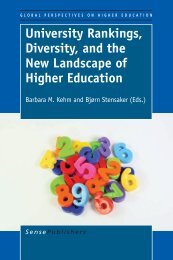Rupturing Concepts of Disability and Inclusion
Rupturing Concepts of Disability and Inclusion
Rupturing Concepts of Disability and Inclusion
Create successful ePaper yourself
Turn your PDF publications into a flip-book with our unique Google optimized e-Paper software.
CHAPTER 2<br />
ethnographic focus for analysis, but also as a locus for social change. Two specific<br />
reasons are outlined: (1) descriptions <strong>of</strong>, <strong>and</strong> responses to, ‘impairment’ as<br />
described in the theological narratives recorded in the Hebrew Scriptures <strong>and</strong><br />
Christian Scriptures have shaped practices <strong>of</strong> how ‘people <strong>of</strong> God’ perceived,<br />
treated, <strong>and</strong> lived with people with disabilities; <strong>and</strong> (2) Christian churches, in the<br />
past <strong>and</strong> in the present, represent a large body <strong>of</strong> responders <strong>of</strong> care <strong>and</strong> serviceproviders,<br />
<strong>and</strong> therefore, provide not only a site for historical reflections <strong>of</strong><br />
‘traditional’ practices, but also a site for creative refiguration <strong>of</strong> disability practices<br />
using contemporary scholarship.<br />
How Judeo-Christian beliefs <strong>and</strong> practices have intersected with philosophical<br />
notions <strong>of</strong> the superiority <strong>of</strong> the mind, the orthodoxy <strong>of</strong> reason, the primacy <strong>of</strong><br />
rationality, <strong>and</strong> the control <strong>of</strong> the body is also noted. I describe how some humans<br />
who fail to be full, autonomous persons are excluded from full moral consideration<br />
<strong>and</strong> significance, are unprotected by any theodic considerations, <strong>and</strong> can be at risk<br />
<strong>of</strong> vulnerability <strong>and</strong> disposability. Therefore, I contend that ethical debates <strong>of</strong><br />
personhood <strong>and</strong> human status must necessarily inform discussions <strong>of</strong> inclusion <strong>and</strong><br />
exclusion.<br />
A scan <strong>of</strong> the literature suggests that in recent times, two approaches have<br />
dominated practices <strong>and</strong> scholarship about inclusion: the technical approach <strong>and</strong><br />
the legislative approach. However, I propose another approach – an ethical<br />
approach, which challenges exclusion as well as the inadequacy <strong>of</strong> technical <strong>and</strong><br />
legislative processes; <strong>and</strong> identifies hidden assumptions which cause flaws <strong>and</strong><br />
problems for people with intellectual disability in particular. I assert that there is an<br />
implicit requirement to also underst<strong>and</strong> notions <strong>of</strong> pr<strong>of</strong>ound exclusion – exclusion<br />
practised ontologically as well as socially.<br />
Therefore, this research undertakes a conceptual theoretical analysis <strong>of</strong> the<br />
ethical significance <strong>of</strong> the notion <strong>of</strong> inclusion for people with disability as conceptualised<br />
in Western Judeo-Christian society. It becomes apparent that the hegemonic<br />
genesis <strong>of</strong> the traditional approaches to applied ethics <strong>and</strong> the legitimacy <strong>of</strong> their<br />
orthodoxy <strong>and</strong> dominance be contested for their implicit exclusion <strong>of</strong> people with<br />
intellectual disability. I suggest that it is not a notion <strong>of</strong> impaired bodies that<br />
presents barriers to Ethical <strong>Inclusion</strong>: rather, it is impaired ethical theorising.<br />
However, a challenge emerges as to how a researcher can best work with<br />
seemingly disjointed fragments to construct an adequate explanation <strong>of</strong> the ethical<br />
significance <strong>of</strong> the notion <strong>of</strong> inclusion. I choose to meet such a challenge by using<br />
metaphor. First, I adopt the metaphor <strong>of</strong> the researcher as a bricoleur, <strong>and</strong> then, I<br />
invoke the metaphor <strong>of</strong> a patchwork quilt by which to describe how the methodology<br />
<strong>of</strong> this research can be conceived.<br />
I describe how, as a feminine artform, patchworking embraces creativity,<br />
multimethod, narrative <strong>and</strong> counterculture – elements that I identify as necessary to<br />
explore the multifaceted nature <strong>of</strong> inclusion.<br />
Finally, in determining the metaphorical process, I indicate how the top layer <strong>of</strong><br />
the quilt will be prepared. Therefore, I identify three steps to be undertaken: attention<br />
to texture, choice <strong>of</strong> an appropriate ethical framework, <strong>and</strong> the laying out <strong>of</strong> all the<br />
fragments.<br />
36














